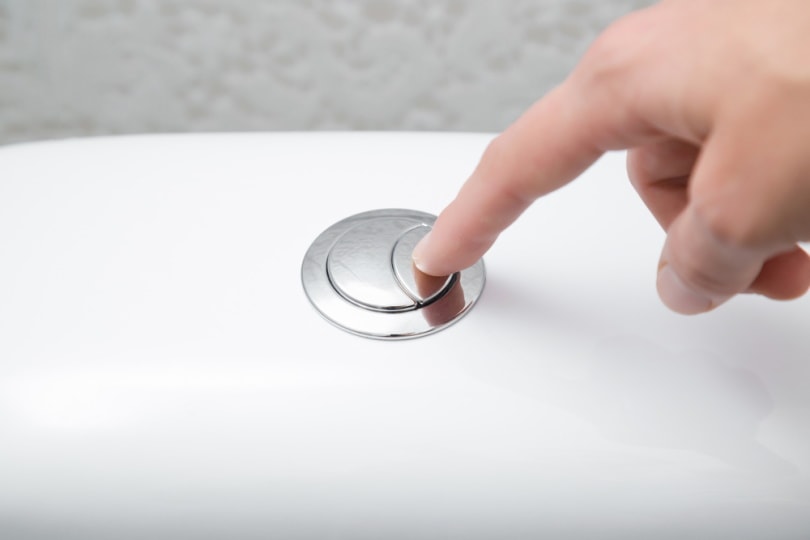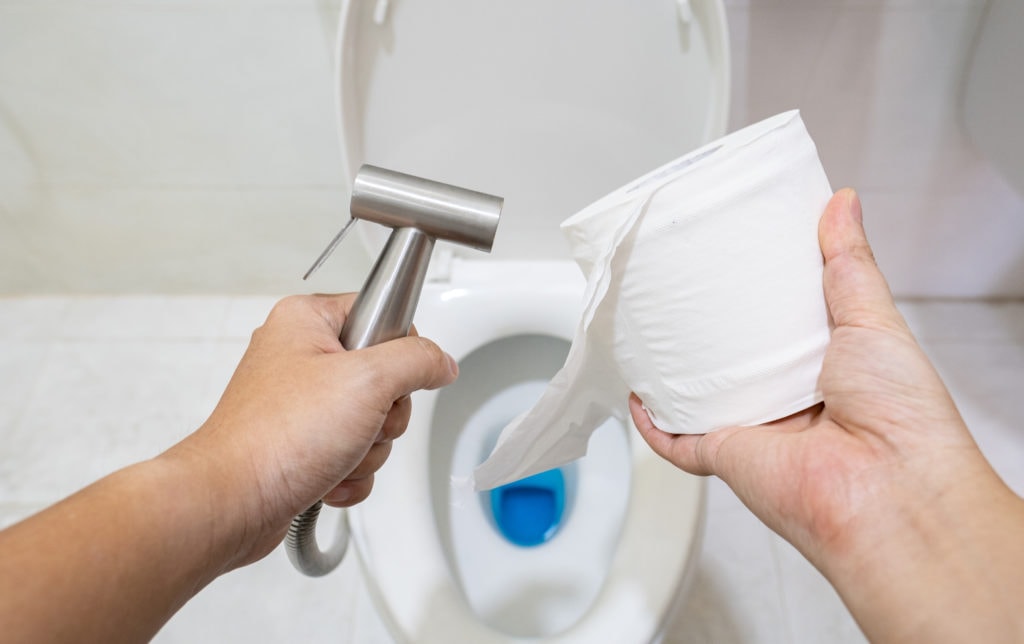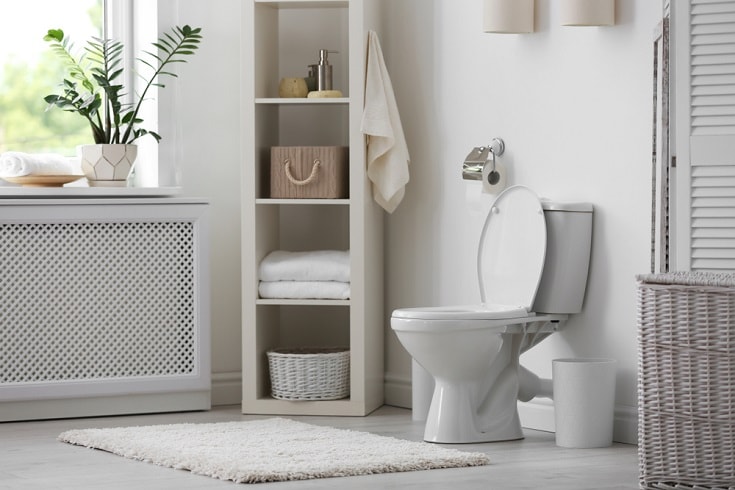What Is a Dual Flush Toilet? Pros, Cons, & FAQ
-
Codee Chessher
- Last updated:

Toilets come in all shapes and sizes, with even different flushing mechanisms. In efforts to conserve water, dual flush toilets were developed and are gaining a considerable following. However, knowing how they differ from regular toilets can be hard. Dual flush toilets are similar to normal toilets, but they feature two flushing mechanisms. Let’s find out what dual flush toilets are, how they work, and some other relevant info.
What Are Dual Flush Toilets and How Do They Work?
At a glance, dual flush toilets look much like regular toilets except with two flushing mechanisms. They have a dual valve that activates via a handle and button/lever. The handle activates a toilet siphon for flushing solid waste, and the lever or button activates a drop valve to flush liquid waste.
Dual flush toilets use much less water than regular toilets because they typically use little to no water for liquid flushes as well as a smaller amount of water for solid flushes. Liquid flushes largely use a gravity-based system that simply flushes liquid away, while solid waste needs some pressurized water to get flushed. However, even solid flushes use a half-bowl of water or less.

The other main characteristic of a dual flush toilet is a larger trapway at the bottom of the toilet. By using less water and a larger trapway, the toilet has an easier time flushing waste. By cutting out water for liquid flushes and reducing it for solid flushes, you can save hundreds to thousands of gallons of water per year with a dual flush toilet.
To use a dual flush toilet, there are typically several water flush levels you can choose. A drop symbol, half-circle, or full circle symbol respectively use less to more water for a flush. A drop is usually more than enough for a liquid flush, while a smaller solid flush will use the half circle. Large solid flushes use the full circle, which uses the most water.
The exact mechanisms on a dual flush toilet will vary, but there are always at least two activating mechanisms. They might even lack the water symbols, but the toilet’s accompanying manual will inform you about how the toilet works.
What Other Toilet Systems Are There?
Dual flush toilets are far from the only type of toilet. In fact, many people have probably only heard of or used some of the toilets we’re about to describe. Let’s check out what other toilets we use on a daily basis and how they differ from dual flush toilets.
- Ballcock Flush Toilets; These are probably the most familiar type of toilets, with a ballcock and plunger that allows water into the tank and bowl. When the rod attached to the ballcock is triggered, it lifts the plunger and lets water flow into the bowl.
- Flapper-Flush Valve Toilets: These toilets have a very similar setup to ballcock flush toilets. Instead of a ballcock and plunger, it has a flapper. The flapper fills with air and floats when you flush, which allows water to flow into the bowl. At a lower water level, the flap closes and the tank refills.
- Siphon Flush Toilets: Siphon flush systems are becoming more popular, allowing your toilet waste to flow directly into a septic tank. These toilets have a simple valve controlled by a floating lever. Activating the lever opens the valve, flushing away waste and allowing the bowl to refill with water.
- Washdown Toilets: Washdown toilets are fairly straightforward in operation. They force water into the bowl, which moves waste down a large trapway. When the water and waste flushes away with vacuum action, you’ll hear a gurgling sound that indicates your flush was successful.
- Gravity Flush Toilets: Gravity flush toilets are possibly the oldest toilets, and they’re still widely used today. These toilets force water into the bowl, which uses gravity to wash away waste. There’s no siphoning action in these toilets, which helps keep your bowl clean. Notably, gravity flush toilets have a very gentle flush.

Where Are Dual Flush Toilets Used?
As we’re becoming more environmentally aware, saving water is becoming very important. Dual flush toilets can be installed in regular homes to reduce toilet water usage by as much as 70%. This significantly reduces your home’s eco-footprint and just as importantly, saves you money on your water bill.
Dual flush toilets can be tricky in homes with children that have a harder time grasping the different flush mechanisms. Without proper instruction, getting a dual flush toilet to save water can backfire and use more water. This especially happens when kids use the wrong mechanism after using the toilet and have to flush again.
However, used properly, dual flush toilets can be a huge boon to your bank account and help reduce strain on your local water supply. In areas suffering from drought and water advisories, this can be invaluable.
Advantages of Dual Flush Toilets
Dual flush toilets have their own pros and cons, just like any other toilet. In most cases, the advantages outweigh the cons, but let’s first find out why you might want to switch to a dual flush toilet.
- Saves Money: Water bills aren’t cheap and increasing water shortages continually drive prices skyward. By replacing one or two toilets with dual flush systems, you can reduce your water bill by 20%–60%. New homes that have dual flush toilets installed may also qualify for local, state, and federal tax incentives.
- Help the Environment: Water consumption isn’t talked about as much as electricity, but it’s still important in its own right. With toilet flushes using as much as 30% of your monthly water bill, dual flush toilets help keep more water in the environment. If everyone in areas suffering water shortages switched to dual flush toilets, the strain on the water supply would be greatly reduced. A lesser-known aspect of this is that dual flush toilets contribute much less to wastewater production, so less water has to be treated and purified.
- Enjoy a More Modern Bathroom: Dual flush toilets oftentimes have sleek metal buttons that set them apart, which can help make your bathroom seem more modern. Cutting out the dangly levers can contribute to a minimalist aesthetic that’s becoming more and more popular. While some cheaper toilets won’t look much different than regular toilets, most are noticeably different.

Disadvantages of Dual Flush Toilets
They save a lot of water and look sleek, but dual flush toilets have some drawbacks you should be aware of. Before investing in one, you should ask yourself if the pros outweigh the cons.
- Requires More Cleaning: Traditional toilets use water to not only flush but keep the bowl clean by washing away excessive liquid and solid waste particles. Dual flush toilets use much less water, which means your toilet bowl will require more regular cleaning than a typical toilet. If you despise cleaning the toilet bowl, this might be a deal-breaker.
- Costlier to Maintain: Dual flush toilets aren’t standard in most places yet, so they rely on proprietary parts from manufacturers. Also, not all plumbers are familiar with how they work, or charge more to work on them. To fix a dual flush toilet, you may have to contend with the manufacturer and special plumbers who’re trained to work with them.
- Lack of Variety in Design: Dual flush toilets are at home in minimalist homes, but homeowners seeking a more traditional design might be disappointed. The good news is that toilet manufacturers are branching out and producing more dual flush toilets that have levers for a more “normal” appearance. In a lot of cases, though, those toilets are harder to find and command higher prices.
Frequently Asked Questions (FAQs)
What are the biggest problems with dual flush toilets?
There are a few main issues you might face with a dual flush toilet. Because the toilet has a rubber seal, it can deteriorate and allow water to constantly flow in. As you can imagine, this totally ruins the toilet’s intended water efficiency.
The other biggest problem is a lack of awareness. A homeowner might install the toilet in a home with children and not know they need to be taught how to use it. Improper use of the toilet can waste a lot of water and defeat the purpose of the dual flush mechanism.
Is a dual flush toilet right for me?
Dual flush toilets work best in homes that want to conserve water. However, if you hate cleaning the toilet, you’ll be nonplussed to learn that dual flush toilets need to be cleaned more often than regular toilets. The main question you need to ask yourself is if extra cleaning and more costly maintenance is worth the water you’ll save.

How do I identify a dual flush toilet?
At a glance, dual flush toilets may seem like fancy toilets that happen to have buttons on top. However, the presence of two buttons on the toilet is the best way to tell a dual flush toilet from a regular toilet. This means it has a half-flush and full flush function.
Dual flush toilets sometimes have levers, too. Those are harder to tell apart at a glance because the lever controls both flushing mechanisms. Dual flush toilets with levers will usually do a half-flush by moving the lever up, while moving it down will do a full flush. This varies based on the toilet type, though.
Conclusion
Dual flush toilets can be one of the best ways to save water in your home, but they require you to be okay with frequent cleaning and costlier upkeep. If you don’t mind those, though, and want to save some cash, dual flush is the way to go.
Featured Image Credit: FotoDuets, Shutterstock
Contents
